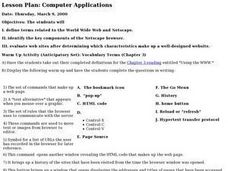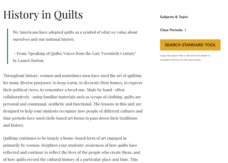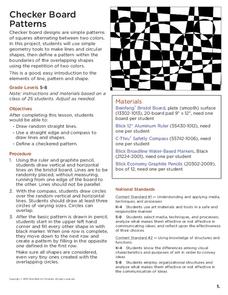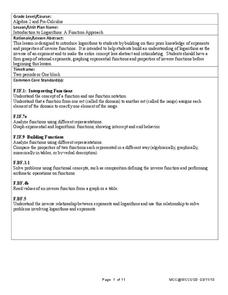Curated OER
Flower Pot
Students identify and discuss the tin-glazed earthenware of viceregal Mexico including the process and the design of these two pieces. They define and apply the concept of radial symmetry. Students design and create their own Talavera...
Curated OER
Families: Different and the Same
Students compare varying family structures. In this family structures lesson plan, students write a book about their family. Students read The House on Mango Street.
Curated OER
Build a Sturdy Wall
Learners read a version of "The Three Little Pigs" and then work in small groups to design a wall. They use Legos to build the wall and subject their design to a strength test.
Curated OER
Computer Applications - 2
High schoolers define terms related to the World Wide Web and Netscape. They identify the key components of the Netscape browser and evaluate web sites after determining which characteristics make up a well-designed website.
Curated OER
Ammonium Nitrate - Heat of Solution
Young scholars quantify the relationship between temperature, energy and heat
and define an endothermic reaction. They measure the energy change caused by dissolving one mole of ammonium nitrate in water.
Curated OER
Lawton: A Child of the Prairie
Pupils complete word study activities, read a story and write a descriptive paragraph about the setting of Goo Goo Avenue in Lawton 1901.
Curated OER
Lesson: Text Messages
Can a neon sign be considered art? Kids consider two different works that use neon text as the basis for conveying artistic social messages. They then analyze a truism from Jenny Holzer's web site that holds meaning to them personally....
Curated OER
Graph Paper Patterns
Young artists divide a piece of graph paper into sections using rectangles, squares, and triangles. They then fill each section with patterns of shape and color. Elementary graders describe how their patterns are organized. Secondary...
Creative Visions Foundation
Developing a Structure for Documentaries
Provide some group brainstorming and story-planning time with the fifth lesson in a series on examining and creating documentaries. After you've explained the purpose of each section of a documentary, groups meet to plan the beginning,...
Curated OER
Lewis and Clark: Prized Possession
Students create a Sacagawea-inspired wampum belt. In this Native-American instructional activity, students study Sacagawea and her influence on the Lewis and Clark expedition. Students learn about wampum and prized possessions and work...
J. Paul Getty Trust
Expressing Emotions through Art Lesson 4—Everybody Celebrates
Young scholars create a celebratory hat after viewing images of artwork depicting people celebrating an event. In this artistic perception lesson plan, students discover why people celebrate their accomplishments and how to express...
Curated OER
Solid Waste Recycling
Students seek scientific and technological solutions to envrionmental problems. They record class activities in a journal. They identify relationships among living things and their environments.
National Endowment for the Humanities
History in Quilts
Learners investigate the use of cloth-based art forms intended to pass down traditions and history. They research types of quilts, quilt characteristics and then identify how Freedom Quilts were historically used in the US.
Mathematics Vision Project
Module 6: Congruence, Construction, and Proof
Trace the links between a variety of math concepts in this far-reaching unit. Ideas that seem very different on the outset (like the distance formula and rigid transformations) come together in very natural and logical ways. This...
NOAA
The Biogeochemical Cycle
The biogeochemical cycle ... no physics? The fourth installment of a 23-part NOAA Enrichment in Marine sciences and Oceanography (NEMO) program introduces the biogeochemical cycle by having pupils simulate movement between Earth's...
Curated OER
Theater: Create a Script
Figurative language is the focus in the book Teach Us, Amelia Bedelia. After reading Peggy Parish's book, class members dramatize idioms from the text, using dramatic strategies such as characterization, exaggeration, and...
Code.org
Event-Driven Programming and Debugging
Start programming in event-driven style. Scholars learn to place buttons on the user interface and use event handlers. They also learn to recognize errors in code and debug as necessary. This is the second lesson in the series of 21.
Curated OER
Checker Board Patterns
Make these funky checker board patterns. They will not only add fun decoration to your classroom, but your pupils will be able to practice using simple geometry tools.They will use tools to make lines and circular shapes using a ruler,...
Curated OER
German Energy Conversations
Young scholars identify and interpret the current German energy mix and trends, as well as to make comparisons and contrasts to that of their own country. They write a two paragraph description of including its likely position in the...
Teach Engineering
Alloy Advantage
Mix it up by using an intriguing resource that teaches young metallurgists that alloys are a metal mixture. They learn about the advantages of using alloys over pure metals and investigate titanium alloys as an example to finish the...
Curated OER
Crazy Quilt Texture Board
Artists explore textures they can create when working with acrylic modeling paste. In this simple-to-implement art lesson, learners divide a rigid surface into six squares, and use a variety of tools to create different textures within...
West Contra Costa Unified School District
Introduction to Inverse Functions
Ready to share the beauty of the inverse function with your classes? This algebra II lesson guides the discovery of an inverse function through a numerical, graphical, and an algebraic approach. Connections are made between the three,...
West Contra Costa Unified School District
Introduction to Logarithms
Build on pupils' understanding of inverse functions by connecting logarithmic functions to exponential functions. This activity allows individuals to see graphically the inverse relationship between an exponential and logarithmic...
Kenan Fellows
Isotopic Pennies
Many people confuse atomic mass and atomic numbers. The sixth of seven lessons in a unit requires scholars to find the weight of different groups of pennies. Then, they must solve how many of each type of penny exists in a closed system...























